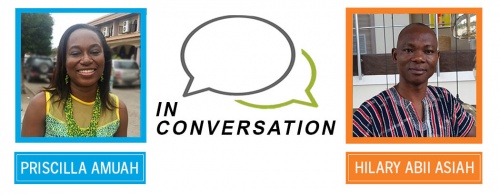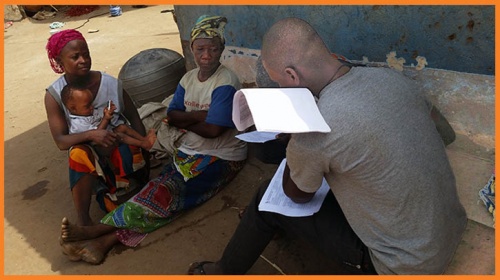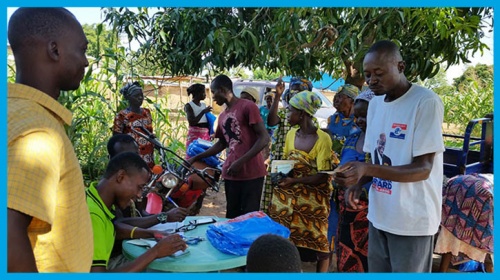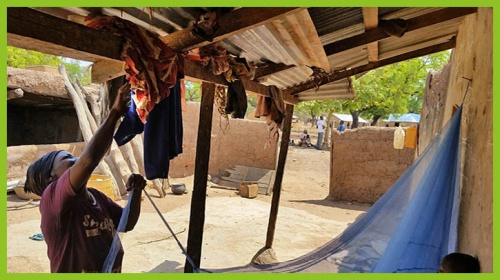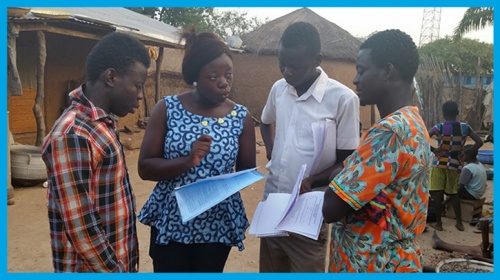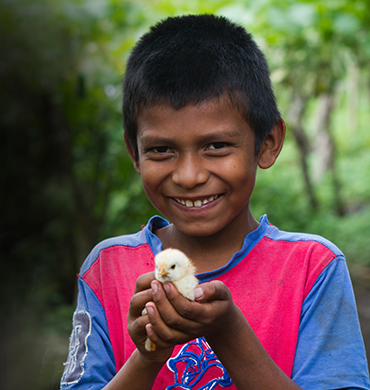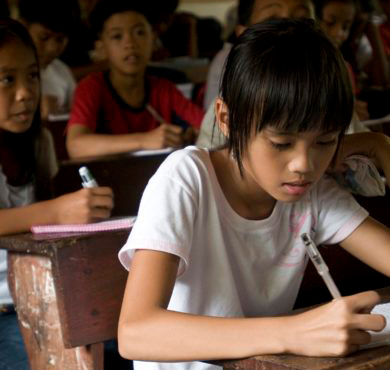World Malaria Day: A conversation about legacy, process and a commitment to reach more families
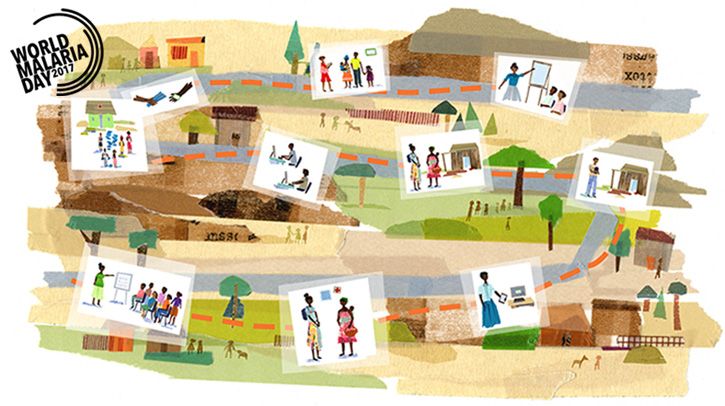
Introductions
April 25th is World Malaria Day. In this conversation, we speak with program officers, Priscilla Amuah and Hilary Abii Asiah about the legacy and impact of our Netsforlife® malaria prevention program and the expanding partnerships that are helping us reach more families. We also gain a deeper understanding of our role in the monitoring and evaluation process.
Episcopal Relief & Development: In 2006, Episcopal Relief & Development started out with NetsforLife®, then a pilot program for malaria prevention and control. Today, we’ve moved to a more integrated model. Why is the integrated health messaging so important?
Priscilla: Our integrated health messaging focuses on malaria, diarrhea and pneumonia. These three diseases are part of the leading cause of morbidity and mortality in children under five years, accounting for about one-third of these deaths. if mothers/caregivers knew the risk and ways to prevent and seek treatment, most of these deaths in children under the age of five could be prevented. That’s why the messaging is so important. We train community volunteers and emphasize what’s called social behavior change communication or SBCC to interrupt the usual behavior. This interruption ultimately prevents these diseases from proliferating.
Episcopal Relief & Development: Can you tell me more about the trained community volunteers? What does their work look like practically, tactically?
Priscilla: It’s basically one person per community depending on the community size. On a monthly basis, volunteers visit all the homes registered under their assigned area and share messaging on malaria, diarrhea and pneumonia. This approach is called integrated community case management or iCCM for short and is focused on the hardest to reach places. It’s a one-on-one communication and caretakers are free to ask any questions they have, seek any clarification and get this personal help.
Episcopal Relief & Development: For over 10 years, the program team has built the NetsforLife® program and methodology from the ground up. Can you talk about that?
Priscilla: With our church partner in Ghana, ADDRO, Anglican Diocesan Development and Relief Organization, we were working in six regions with a total of seven sub-districts. At the time, we were deploying nets, following up on usage 18-months after nets were distributed and sharing health messaging at the household level. We also started training and equipping community-based volunteers to diagnose and treat children under five years suffering from malaria, diarrhea, and pneumonia.
Episcopal Relief & Development: Can you tell us how the expansion of the monitoring and evaluation (M&E) part of our malaria program emerged?
Priscilla: It started back in 2010 when we joined the Ghana Health Service and National Malaria Control Programme (NMCP) in the country to do the first ever hang-up campaign. The initiative combined net distribution with education to promote “net culture,” a method that leads to people embracing effective ways to use and maintain nets beyond the lifespan of the one being distributed. That event involved a lot of nets being distributed in one week and hung over the sleeping areas of people’s homes. The NMCP really liked the process and outcome, and although it was more expensive than the usual point distribution, we know it was worth the cost for the long-term impact. So, it was an incredibly successful campaign.
In 2015, Against Malaria Foundation (AMF) contacted NMCP and said they wanted to work with them to distribute 2.6 million nets around the country by the end of 2016. AMF needed a partner on the ground to conduct the follow-up/post-distribution check-ups. The NMCP recommended us. By March 2016, we were in partnership.
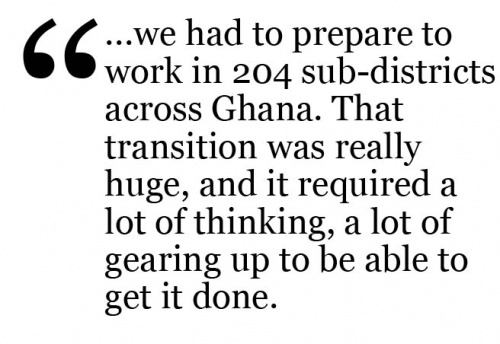 As I mentioned before, we were in seven sub-districts, but when we agreed to partner with AMF, we had to prepare to work in 204 sub-districts across Ghana. That transition was really huge, and it required a lot of thinking, a lot of and gearing up to be able to get it done.
As I mentioned before, we were in seven sub-districts, but when we agreed to partner with AMF, we had to prepare to work in 204 sub-districts across Ghana. That transition was really huge, and it required a lot of thinking, a lot of and gearing up to be able to get it done.
Episcopal Relief & Development: So previously we had been concentrating on deepening our program with the health messaging or iCCM, but the AMF partnership is really about monitoring and evaluation and doing follow-up – we had to scale quickly. Can you talk about that process?
Priscilla: To distribute, monitor and evaluate at this scale, we had a pre-distribution phase, the distribution phase and then the post-distribution phase. For the pre-distribution phase, we did various meetings and planning workshops with major stakeholders in the regions and districts. We had to do an orientation for the registration process. Volunteers were trained to go to each household to gather relevant information – the number of people in the household, the location, the telephone number, etc. After households were registered, they were given a coupon to redeem their nets during the distribution period.
All this was done to help identify the total number of people in each of the communities, the subdistricts, the districts and the regions. Then, we could determine how many nets (LLINs) to send in during the distribution phase. The actual distribution phase in each of the regions took approximately one week.
During this period, the families who are registered show up at the distribution points with a coupon. It is verified, and the number of nets that they are supposed to be given for each coupon are provided. On average, it’s two people per net. Episcopal Relief & Development, in partnership with ADDRO, monitor the entire process and support NMCP in any way possible during these two critical phases.
Episcopal Relief & Development: Hilary, what’s your take? I hear that our team ensures that the nets are hung – we’ve been doing this for a while – but how do people respond to that? You’re in their home, does it feel invasive or do they feel that our volunteers are careful and thoughtful during the distribution process? How do you maintain a sensitive relationship when you’re in their homes?
Hilary: We have what we call the household entry aspect of the training, where we emphasize the need to establish proper rapport with people, particularly with those in charge of the home. It’s simple things like showing respect, making eye contact, being attentive to questions, engaging in active listening and observing and being mindful of the norms. It helps that people are from the community. From our experience, when this is done, you’re warmly welcomed. They open their door and say, “You can come in and see my net, my children and I are all using them.” It’s actually so cordial, we rarely see any opposition. They understand the benefits.
This process takes time to build and money to carry it out, but it’s really worth it. Additionally, the strong structures and networks can be used for other interventions. For example, we worked through existing networks from malaria and iCCM for Ebola response activities.
 Priscilla: Yes, just like Hilary was sharing, the way that we train our volunteers, they are able to establish that relationship. From the beginning, the community volunteers are the same people that go in there to register the households. Right from the word go, members of the community have that connection and trust with volunteers. This cohesion is so important, and it’s how we approached the whole thing. We just don’t push our way into communities. We seek and train local volunteers. For example for the GiveWell event I mentioned earlier, we also had the district health management team on the ground. It’s that whole process of working collaboratively with people and making sure that once we get into the communities, we really see that deep connection. Some people are so proud to show their nets hanging. It’s great!
Priscilla: Yes, just like Hilary was sharing, the way that we train our volunteers, they are able to establish that relationship. From the beginning, the community volunteers are the same people that go in there to register the households. Right from the word go, members of the community have that connection and trust with volunteers. This cohesion is so important, and it’s how we approached the whole thing. We just don’t push our way into communities. We seek and train local volunteers. For example for the GiveWell event I mentioned earlier, we also had the district health management team on the ground. It’s that whole process of working collaboratively with people and making sure that once we get into the communities, we really see that deep connection. Some people are so proud to show their nets hanging. It’s great!
Episcopal Relief & Development: Let’s continue with the process. There’s a pre-distribution phase which is all about identifying participants and deciding how much we need to distribute. Then there’s the point distribution that happens for a week. Can you talk about the post-distribution phase?
Priscilla: Before we get to the post-distribution phase, I would like to also say that we all acknowledge that within that one week of distribution, not everyone who was registered shows up with the coupons to claim their nets. Therefore, we give people a grace period of one month to allow those who couldn’t redeem their nets time to do so.
After the grace period, net distribution ends and the post-distribution validation can begin. A post-distribution validation is basically finding out how many of the nets we distributed actually ended up in designated households. We train people to go into the communities to check that the nets got to the homes as planned. We also make sure that the hanging took place and the nets are appropriately being used. It’s called End-User Verification.
We have trained “validation teams.” The validation is not done by the community volunteers that helped with the registration and distribution but by other independent people. These people are trained to check how many nets were distributed. For instance, if we show that a particular home should have received three nets, they confirm that these nets were received and are properly being used in the household.
GETTING NETS TO MORE FAMILIES | A DIGITAL FLIP BOOK
Episcopal Relief & Development: Can you talk a bit about the data collection?
Priscilla: Sure, after the post-distribution validation, all the coupons are packaged. A coupon has the name of the head of household, the number of people in the home, the location and the contact information. The post-distribution validation teams and ADDRO staff package them into communities, sub-districts and districts, then they are transported to the data entry centre at ADDRO headquarters in Bolgatanga, Ghana. There we have about 60 data entry clerks working two shifts on 30 computers. The first data entry comprises the registration and distribution data. The database is very robust. You can trace each head of household and then get all the information about the registration, the distribution and the follow-up.
Hilary: I coordinate this part of the program. It involves linking up with the various stakeholders, like ADDRO, who is our major implementing partner. I also coordinate with AMF, providing feedback on any issues they might be interested in as the data is entered into the database. I supervise the trainings, monitor the data collection and manage the data center. I try to observe the process, looking for opportunities to improve and modify it for more efficiency and simplification.
Episcopal Relief & Development: Where do we stand now in the program? Are we in the post-distribution phase?
Priscilla: Exactly, at the moment, what is happening is that all nets have been distributed, we are in the Post-distribution check-up phase in all the regions. I would say at least the first round of data collection has been completed at this point. We are on the data entry and analysis for one of the regions now. This is the time where we continue the training with the volunteers to do the integrated health work.
Episcopal Relief & Development: Can you say more about the Post-distribution check-ups?
Priscilla: Post-distribution check-ups happen every six months after the distribution, it’s a snapshot in time that helps the team track net usage. The whole process usually lasts about a month or so. We train people to do a data survey in the field. It helps us determine the availability of the nets and the usage of the nets within the households. They also check whether anyone in the home recently contracted malaria. We’re trying to determine whether the nets that were distributed are still in the system and if the usage rates are successful. That data is also packaged and sent to the data entry center and analyzed against the registration and distribution data. The goal is to get a robust picture of the impact over time. Coupled with the integrated health messaging, we’re trying to have a multiplier effect to improve lives. 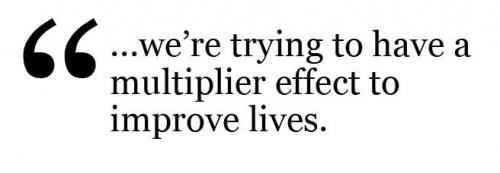
Episcopal Relief & Development: That makes sense. In your experience, what are the strengths of the system? Where do you see the challenges?
Hilary: I think the overall strengths of the system are related to the structure and the network of existing relationships with Episcopal Relief & Development partners and major stakeholders. Earlier on, Priscilla explained how we started with the National Malaria Control Program and Ghana Health Services, that cooperation already existed. In addition, our long-time relationship with the implementing partner is going well. This serves as a great example of effective collaboration and coordination. Our partners are well established and trusted within the local communities in various ways, so that allows for an easier flow of information and activities.
We have good strong, open communication with AMF. If there is an issue we discuss it and include other stakeholders as needed, down to the community level. There’s always this attitude of good cooperation. The GiveWell event was key.
The challenges have come up, particularly in the area of communication. Phones or the internet may not work well and that can slow things down. At times, there are language barriers with understanding a local dialect. And, we have to work together to address these issues.
Priscilla: Also, it is difficult trying to expand and scale up our very intimate approach of building relationships in 43 districts quickly. We’re working extra hard to maintain the integrity of our method. There is a lot of training going on right now. That trust has to be there for the net culture to take hold. We are trying to build on what we are doing with AMF to also expand messaging around malaria, diarrhea and pneumonia in the communities. We’re excited about the prospect of scaling this big with the integrated health messaging but realize it will probably take a bit longer for all of it to come together in the way we envision.
Episcopal Relief & Development: Is there anything else your team is considering for this program?
Priscilla: Yes, we are planning to add a Savings with Education component. Men and women come together to jointly save, and in turn, take loans from their joint savings. It’s basically to help communities, especially women in households, with medical and health related expenses. We hope to form Savings with Education groups targeting mostly women. The community volunteers will also be a part of the groups since it will be a great incentive for them and it provides another platform for them to share the health messaging they’ve been trained on. It will also offer women in the savings groups the opportunity to pay for health expenses for their families.
About
 Priscilla Amuah received her MPH degree from the School of Public Health, College of Health Sciences, University of Ghana, Legon, and has honed her skills with a number of training courses, including USAID’s online courses. She has over 8 years’ experience in public health programming and was previously the Monitoring and Evaluation officer with Episcopal Relief & Development’s award-winning NetsforLife® program. As Senior Program Officer for Health, Ms. Amuah is responsible for improving key strategies to enhance the integrated health portfolio, managing key program relationships, identifying and integrating best practices within community-based programming for health outcomes, amongst others.
Priscilla Amuah received her MPH degree from the School of Public Health, College of Health Sciences, University of Ghana, Legon, and has honed her skills with a number of training courses, including USAID’s online courses. She has over 8 years’ experience in public health programming and was previously the Monitoring and Evaluation officer with Episcopal Relief & Development’s award-winning NetsforLife® program. As Senior Program Officer for Health, Ms. Amuah is responsible for improving key strategies to enhance the integrated health portfolio, managing key program relationships, identifying and integrating best practices within community-based programming for health outcomes, amongst others.
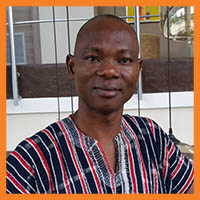 Hilary Abii Asiah has Master in Public Health (MPH) from the Royal Tropical Institute, The Netherlands and PGD in Epidemiology from London School of Hygiene and Tropical Medicine, London, UK. He has 15 years’ work experience focused on Child & Maternal Health, Malaria interventions and conducting operational health research. He has worked with international and local NGOs including the Millennium Villages Project, Ghana Essential Health Intervention Program, Anglican Diocesan Development and Relief Organisation and Health Research Institutions. Hilary is currently the Program Officer for Episcopal Relief & Development and is responsible for coordinating the Against Malaria Foundation program in Ghana.
Hilary Abii Asiah has Master in Public Health (MPH) from the Royal Tropical Institute, The Netherlands and PGD in Epidemiology from London School of Hygiene and Tropical Medicine, London, UK. He has 15 years’ work experience focused on Child & Maternal Health, Malaria interventions and conducting operational health research. He has worked with international and local NGOs including the Millennium Villages Project, Ghana Essential Health Intervention Program, Anglican Diocesan Development and Relief Organisation and Health Research Institutions. Hilary is currently the Program Officer for Episcopal Relief & Development and is responsible for coordinating the Against Malaria Foundation program in Ghana.
Images: Top, Feature graphic, an illustration of the monitoring and evaluation process by Maria Carluccio for Episcopal Relief & Development. Middle 1, Community health volunteer talks with caregivers in Ghana; Middle 2, Point distribution of LLINs in Ghana; Middle 3, Community volunteer hangs a net in a home. Middle 4, Community volunteers discuss the number of nets in the village.

